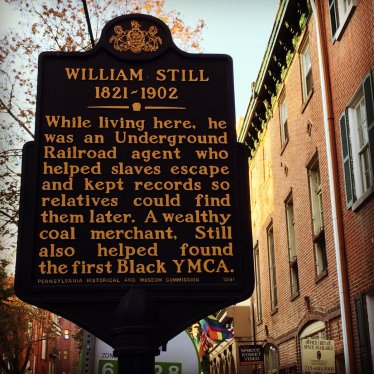
In his most recent episode of America Unearthed, Scott Wolter came to my new home state of Pennslyvania. I’ll admit, I got a little thrill from seeing the state being showcased, especially since the images he used were really cute and complementary. It did strike me though, I live in the oldest continuously occupied city in the United States. (There’s a distinction there to be aware of.) It gives good old Philly a neat layer cake of history and it’s really impossible to touch on all of it in any one post, tv show, or hell, even a movie probably.
Two things the third episode of America Unearthed did bring to light though, were Pennslyvania’s history of secret societies, and it’s participation in the Underground Railroad.

Pennslyvania was home to several old societies, both fraternities, and sororities, and many originate out of Philadelphia. It’s natural as the city itself is 400 years old. Our Masonic Lodge is one of the prettiest (fight me) and we have some of the oldest, still operating structures in the country. Also, we have the liberty bell, and liberty hall, all Masonic, if you listen to the locals.
Which brings me to an interesting point, the intersection of ‘formal’ hisotry and oral history.

William Still was a focus in America Unearthed episode 3 when Wolter appeared to run his secret society thread into the ground. He switched his focus to the Underground Railroad and William Still. This was because he’d found a cave that he couldn’t quite pin down the uses for, and decided to run with an Underground Railroad theme. I say that because there’s nothing to connect the cave with the Underground Railroad or William Still, but due to the way Wolter and the show present his ‘research,’ it creates the illusion that there is.

What’s more, Wolter basically tells two gentlemen on the show that their caves are definitely linked to the Underground Railroad, and in the case of the main cave, links initials he thinks he sees in the cave wall with two former slaves written down in William Still’s journal. What we witness here in this episode isn’t just the passing on of unlinked information as fact, but the creation of and participation in, oral history.
Wolter is set on the trail of the Underground Railroad and Stills by simple word of mouth informants. This isn’t unusual for the show, Wolter’s hunches rely heavily on random, unverified information given to him by informants. He then takes this information and passes it on to the landowners in two incidences, creating a story that links their caves to the Underground Railroad. Both owners seem delighted by this, and who wouldn’t like to think their ancestors were Abolitionists vs Slave Owners?
The problem is, Underground Railroad stops are notoriously hard to pin down by their very nature as secret hiding spaces. Many were simply parts of functioning houses and homesteads, that were used for various purposes over the lifetime of the homes. This muddles the archaeology, as what exactly would we expect to see archaeologically in an Underground Railroad stop, vs what we expect to see in the course of normal daily life? Unless the space stands out, a literal secret room or something like that, we have nothing to tie certain spaces to the Underground Railroad.
That doesn’t stop people from thinking or claiming their homes, homesteads, and ancestors were part of it. And who knows, they may be right, but often these accounts are family or local oral history. There’s the issue, oral histories are often unverifiable and have to be taken at face value. They’re also particularly tricky because, even if there is evidence to support or contradict them, the oral history is often tied into the personal identity of an individual or community. This is what makes oral histories tricky, we don’t want to look like we’re attacking personal identity. Usually, we’re not, we’re just following the evidence, translating it as best we can at the time, and documenting as much of it as we can for future generations to look over and learn from.

Which is the problem with shows like America Unearthed and Wolter’s perceived authority. Wolter isn’t preserving anything, he’s not following evidence or translating things. He’s forcing things into his own perceptions, shoehorning things to fit a narrative he’s already decided on. Then, once he’s done twisting and shaping things to fit, he passes his new story on to others, creating a new oral history that often overrides that of others.
At best it’s disruptive, at worst, it’s blatant erasure of other cultures. It’s also why we need to speak up against this kind of thing. Correct it where we can and continue to find new ways to communicate oral histories with the public. We need to preserve things, and not allow others to appropriate, colonize, and erase other cultures for their own ends.
If you’d like to support the Podcast or site, consider donating to us on Patreon or buy us a Ko-Fi. Either option helps us out.
Check out Jeb Card’s new book Spooky Archaeology :
Myth and the Science of the Past
And Ken Feder’s new book Archaeological Oddities: A Field Guide to Forty Claims of Lost Civilizations, Ancient Visitors, and Other Strange Sites in North America
Grab a t-shirt or coffee mug from our Swag Store on Zazzle.
Be sure to subscribe to the podcast on the blog and like and share us where ever you can.
You can follow us on twitter @ArchyFantasies, or look us up on Facebook. You can reach us by email at ArchyFantasies@gmail.com.
Contact us below or leave a comment.



“Oral history is only as good as reputable as the person saying it”
Abraham Lincoln
LikeLike
Even Lincoln can say big bullshit.
LikeLike
Even Lincoln can say big bullshit.
LikeLike